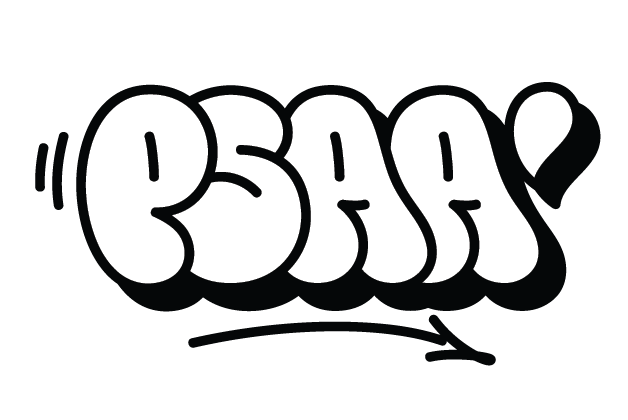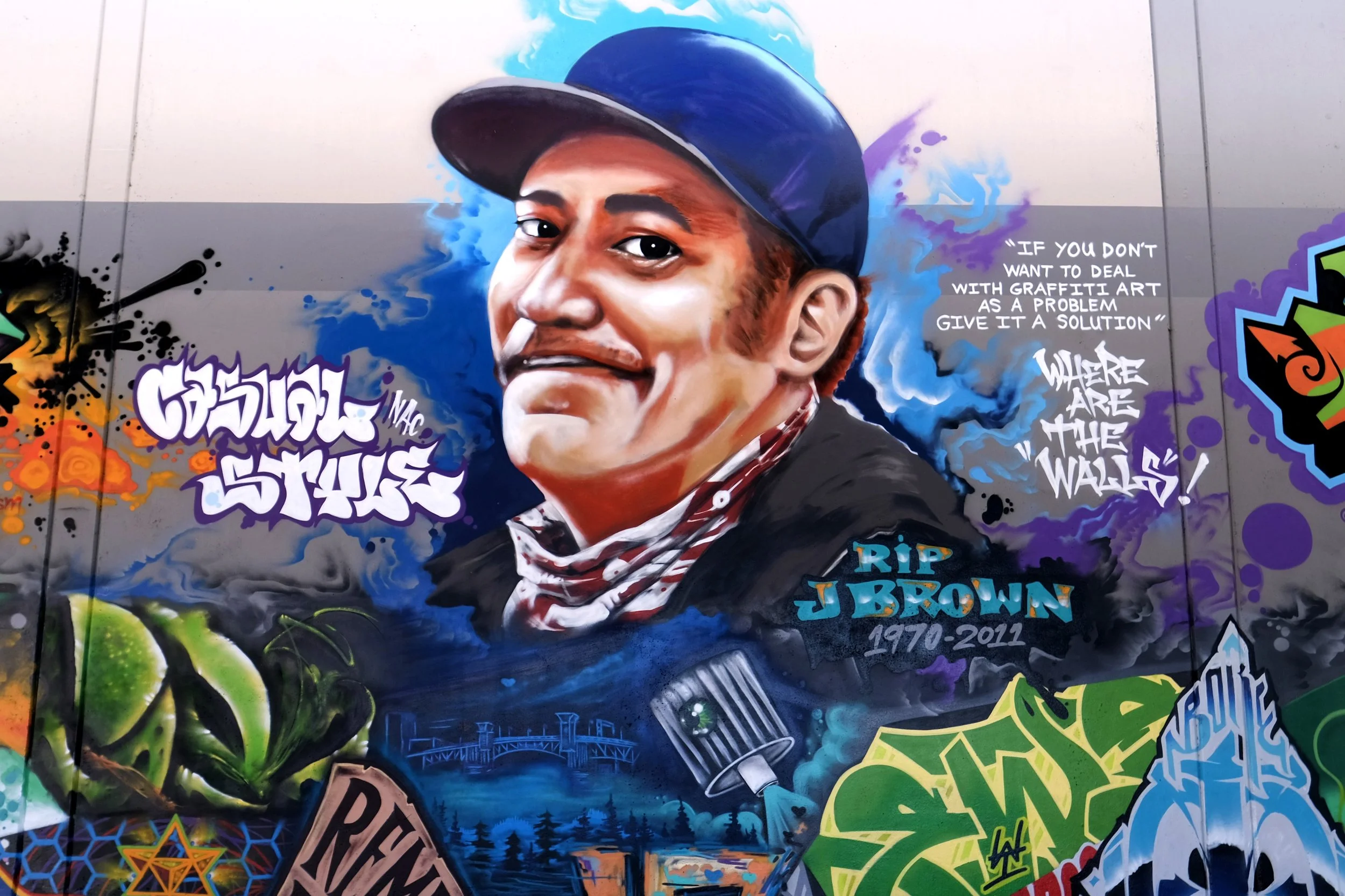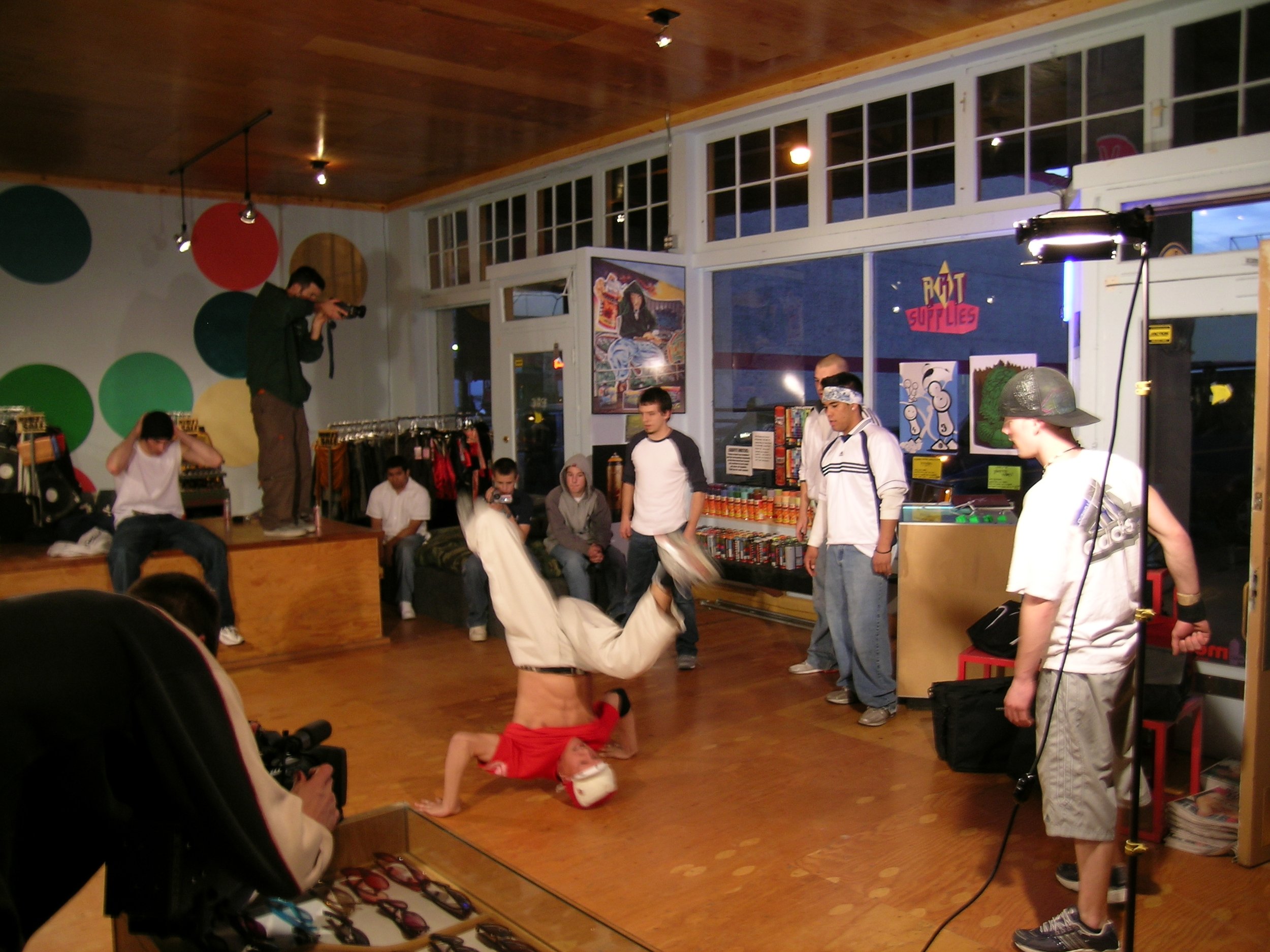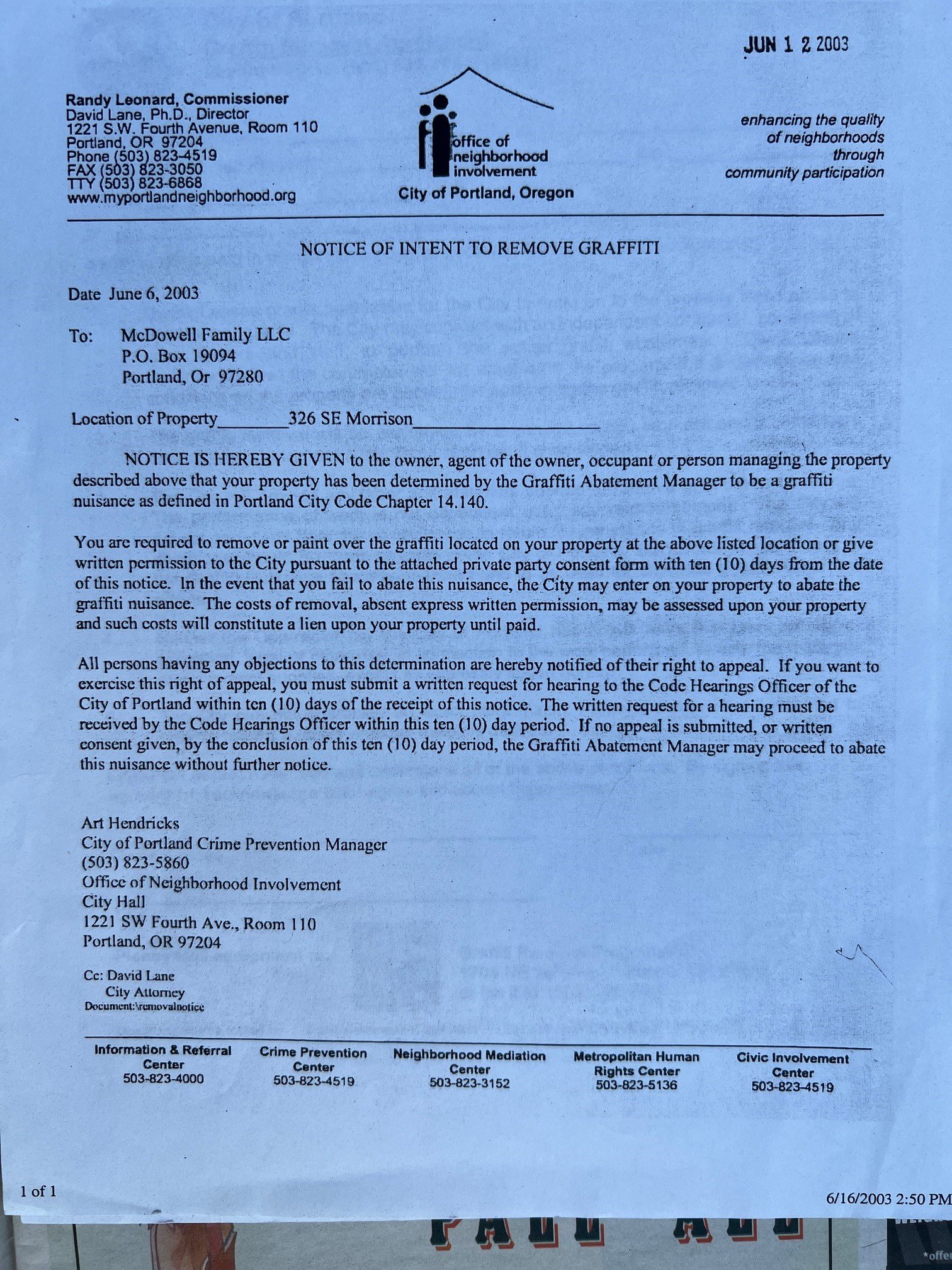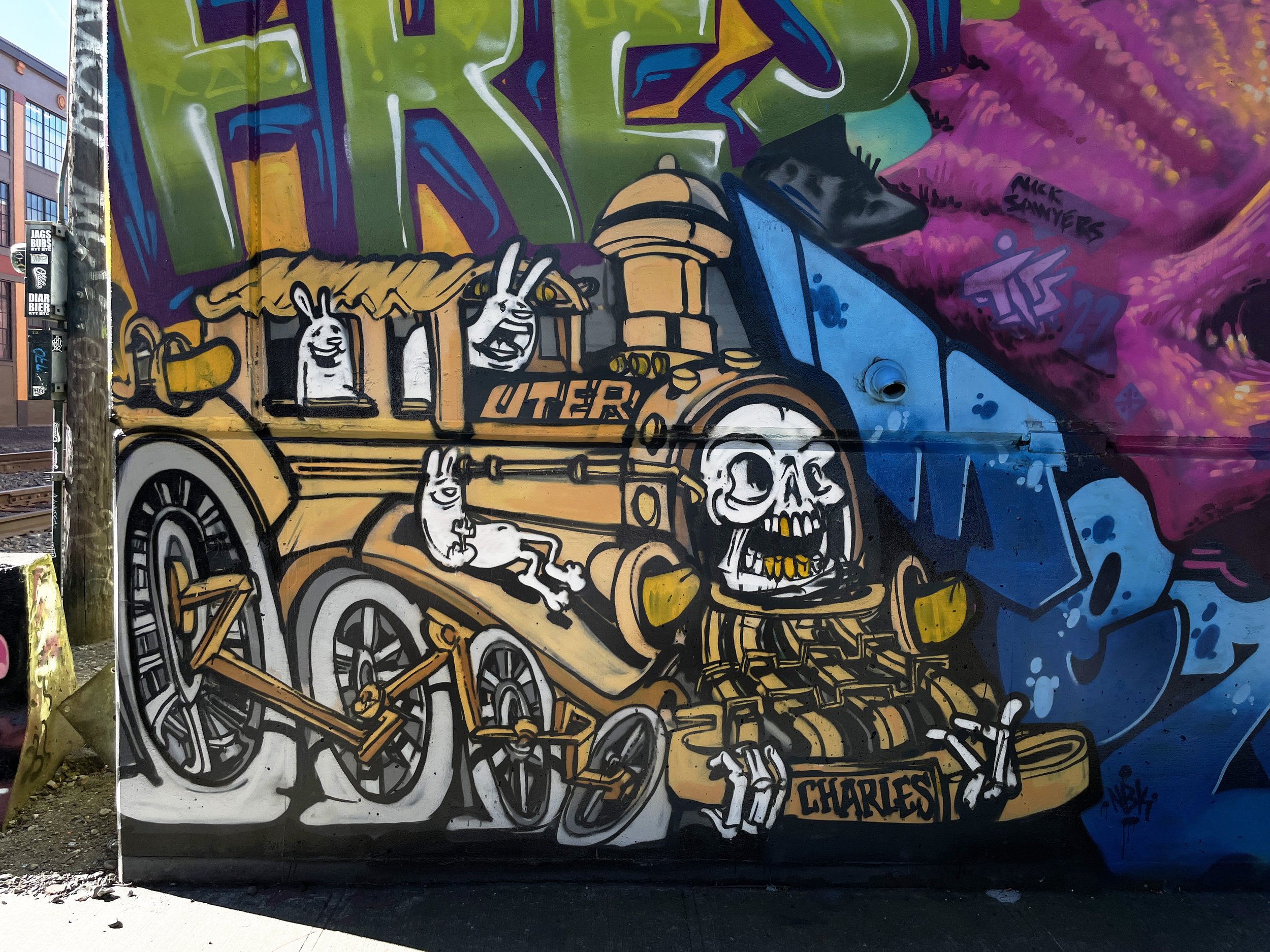JASON BROWN MEMORIAL WALL
PORTLAND, OREGON
Portland Street Art Alliance partnered with artist Jaymeer to help him implement his vision to organize the painting of a new memorial wall, honoring J. Brown and his advocacy work that helped push the City of Portland to loosen its restrictive mural laws.
New mural titled “J Brown Remembrance In Paint,” located on the back of All Service Moving (66 SE Morrison) in the Central Eastside, blocks away from where New American Casuals was located in the early 2000s.
Portland-based muralist and Burnside Skatepark (non-profit board member & art director) community manager, Jaymeer, organized a team of aerosol artists from all over the West Coast to paint a massive mural production honoring the late Jason “J.” Brown (1970-2011), former owner of New American Casuals (NAC), a pioneering Portland streetwear shop located in the Central Eastside in the early 2000s. This new mural is fittingly located just blocks away from NAC’s original location at 326 SE Morrison St.
“J Brown Remembrance In Paint” was painted in a classic graffiti style by internationally respected and recognized graffiti artists. This all-star lineup included Jaymeer, Leon, Mez, Clown, Fresh, Nick Sawyers, Kadie, Nekroe, Flash, Hagr, Hand of Dogg, Saroe, Mewz, and many more.
The production features quotes from J. Brown, and related imagery from the original mural on NAC that sparked a fiery debate about freedom of expression in Portland and the City’s sign and mural codes. If you look very closely along the bottom, taken together, the various wildstyle pieces spell out “Portland” in an abstract style.
To appreciate the messaging and symbology behind the mural, one needs to understand Portland’s unique and complicated history of laws regulating freedom of expression and art in public space. Prior to 1991, artists could paint outdoor murals in Portland with a simple agreement between themselves and the building owner, as is the case in many other cities across the US.
In 1998, the City of Portland was thrust into a lengthy and complicated legal battle with AK Media (a company that was later absorbed by Clear Channel). Sadly, many historic and community murals were lost during this time, commonly known as Portland’s “mural moratorium.” Some murals like the “Art Fills the Void” banana mural on Division (1982) and the “Malcolm X Black Pride” mural off Alberta (1984) were thankfully spared and saved.
A handful of art advocates rose up and pushed for the art of mural-making to be recognized and respected by the City of Portland.
Late muralist Joe Cotter, was perhaps the best known champion of murals in the Portland area, with his activism group Portland Mural Defense. Cotter wasn't an attorney, but he learned about the legal process and used that knowledge to work with a tireless group of mural advocates who fought for greater expression of murals in Portland. Along with fellow Portland Mural Defense advocates Mark Meltzer and Joanne Oleksiak, Cotter worked for many years to make the city sign code less restrictive toward murals. Read more about Portland Mural Defense here and here.
In the early 2000’s New American Casuals was not only a clothing store, but a gathering place that celebrated all thing street.
A lesser known, but equally important hero of Portland mural history was Jason “J.” Brown, owner of New American Casuals. NAC was a streetwear clothing shop / boutique & carried art supplies & had gallery art displayed. NAC was more than a clothing shop or store he hosted gallery shows for artists around the country & world, it was a creative hub for Portland’s aerosol artists – a place where they could gather, sketch in their black books, network, and provide mentorship for kids interested in graffiti-style artwork.
Original New American Casuals Mural
Original New American Casuals Mural
In 2003, Brown allowed graffiti artists to paint a mural on the east wall of NAC. The mural featured a mix of graffiti-style writing and a large figure posing with a can of Belton spray paint. A similar character also is now featured again in the new mural at All Service Moving, the painting includes some of the original artists, like Jaymeer almost 20 years later.
Brown was aiming to show off local artists’ talent and beautify the “drab belly” and “poop-splattered underside of the Morrison Bridge” where NAC was located. Brown said, “we’ve had more honks and cheers from people going by than people stopping to gripe about it.” Brown’s vision was to host a Legal Wall, an ongoing graffiti project that would rotate twice a month, “ranging in everything from graffiti art to stenciling to fine arts” Brown said.
City of Portland's 2003 Graffiti Abatement Notice and Jason Brown's Letter of Appeal to the City.
The NAC mural was painted without a City permit, however, making it technically “illegal graffiti” under the city's sign code. Brown received a graffiti abatement notice and was ordered to paint over it within 10 days or face fines.
Brown appealed, but before the removal deadline approached, the City’s graffiti removal crew painted over the mural, the following day an in progress mural was removed from the opposite side of the building.
After the murals removal Brown and a group of artists began painting other murals, on both sides of the NAC building in protest of the City’s actions. The murals displayed a political message from Mahatma Gandhi; "Civil disobedience becomes a sacred duty when the state becomes lawless and corrupt."
The Oregonian newspaper reported that Art Hendricks, the manager of the City’s Crime Prevention Program in 2003 (later called Graffiti Abatement / Graffiti Program), said the murals were “considered graffiti, subject to removal if not approved under city sign codes.”
The City also issued Brown a citation for failing to obtain a permit. Brown did not have a permit for the mural and said he didn't know he needed one. The City said it was responding to complaints from local businesses it had received about the NAC mural.
Brown consulted with an attorney and sent an appeal letter to the City. He and the artists involved hosted fundraisers and rallied supporters, like Jaymeer, to speak out and come out in defense of legal aerosol art and overly restrictive laws.
“After spending over 2 weeks painting and on scaffolding, I felt my artistic freedom of expression and speech had been suppressed. I had permission from the property and business owners. An appeal to the City was sent in. Our artwork was destroyed without even a reply from the City.” - Jaymeer
"I would have followed the rules, had they been laid down to me and been respected by the people laying them down,” said Brown. It would have cost $1,600 to register the 250-square-foot mural. A substantial cost in 2003, and even so now. At that time, Brown and the artists would have also had to navigate a complicated land use review process and gained approval from the neighborhood association regarding the mural’s style and content.
Brown and other advocates were eager to see the City “loosen the code and allow a greater proliferation of public art that reflects and affirms community and local character,” explained Marjorie Skinner, a local reporter who covered this controversy over the years.
The situation that flared up under the Morrison Bridge at NAC was one of the sparks that ignited a fiery debate over government regulation and freedom of artistic expression, pushing groups like Portland Mural Defense to rise up in support of murals.
Press from The Portland Mercury circa 2003
"These are not illegal graffiti bombers, these are artists," Brown said back in 2003. He wanted to give the artists an outlet and help them get recognition for their work. Brown’s vision was to transform the underside viaduct of the Morrison Bridge in the Central Eastside. Twenty years later that process has finally begun with murals throughout the industrial district, now coined by local artists as the Central Eastside Mural District.
After many years of legal battles, artist protests, and whitewashed permission murals, in 2005 the Regional Arts & Culture Council (RACC) began its Public Art Mural Program. Following the closing of the Clear Channel trial in 2009, the City of Portland’s new mural program was created.
The Future of Street Art in Portland
Until those two pathways (which we still have today) were forged, community murals were either not painted, or were done without City permission, risking citations and fines for building owners for being out of compliance with the City’s sign code.
The bureaucratic process and costs of obtaining permission to paint in Portland continues to be a sticking point and is a cause of much confusion for local and visiting artists.
“Thankfully, thanks to the hard work of artists and advocates throughout the years, the City currently charges $56 for a BDS-issued Original Art Mural Permit. It takes 21 days to secure, and requires certified letter notifications to the neighborhood associations/coalitions, and a public posting notice on the wall. With this permit route, we don’t need to get mural designs approved by anyone other than the property owner. The BDS has no say in what content we paint, who the artist is, or what paint mediums we use.” explains PSAA director Tiffany Conklin who was at the table during the City’s last mural code revision process in 2018.
“Even though the permit system is better, it still doesn't allow for rotations and murals need to be planned well ahead of time. Not all public art has to be static and planned. At PSAA we advocate for a legal route that allows for more organic free expression and less barriers for young and emerging local artists and those who are visiting the city.”
“Recent progress has been made in getting the City to consider allowing for a Free Wall / Legal Wall, though the process is still in its early stages and there’s a lot of huddles to get over.” explains Conklin. Thanks to a PSU research study on the topic, in 2019 Portland City Council said they would consider a pilot Legal Wall program, if an appropriate site was secured.
IN MEMORIAM
Artist gathered to paint for and remember Jason Brown
Sadly, Brown never got to see what the Central Eastside has transformed into today. He was killed in a tragic accident, a house fire in 2011. But thanks to Jaymeer and the local street art community, his image and memory will live on in the heart of the Central Eastside Mural District.
“Jason Brown was a good friend to many Portlanders. I think Jason would be proud to see so much art in the Industrial Central Eastside, close to where his business was located and where his heart was. Twenty years later, I still am advocating and waiting for the day that Portland has a City-sponsored and supported Legal Free Wall for art, perhaps in a park or next to a skatepark. We need accessible walls that diverse people from all walks of life can use to express themselves.”
- Jaymeer
ABOUT JAY MEER
Jay’s Wildstyle on the J. Brown Memorial Wall.
Artist Jaymeer has been managing the mural work at Burnside Skatepark since 1993. An early volunteer at Burnside Skatepark, he helped with construction, building, and maintaining the now world-famous skatepark. With roots in the Midwest, Jaymeer travels nationwide creating commissioned art and donating murals to skateparks. Jaymeer has been a prominent member of the local Portland skateboarding, art, and activist community since 1994. He started drawing at an early age. In 1988, under his mentor, Leon Henry, Jay started to paint with aerosol & airbrush. He now has murals all over the country. He also helped work to build, fundraise & paint for Marginal Way D.I.Y. Skatepark in Seattle, WA est. 2004.
ABOUT PSAA
PSAA started The Central Eastside Mural District this mural initiative in 2018, applying for grants, gathering letters of support, and networking with Central Eastside property owners and businesses. We wanted to carry on the torch of J. Brown, Joe Cotter and other art advocates who have fought for public art in Portland.The goal of the initiative is to promote more inclusive engagement and access to public art-making in the city for those who want to paint legally,” explained PSAA Board President Tomás Valladares.
Read more about PSAA’s Central Eastside Mural District Initiative. Jason Brown famously said “There are amphitheaters for murals, there’s basketball courts for kids that are into sports, but where are the walls?”
Since our founding, PSAA has helped create over 300 street art installations, collaborating with hundreds of artists in the region and facilitating commissions resulting in over $950,000 paid to working artists. Street art is inherently democratic; providing access to artistic expression for the entire community, not just a privileged few who have access to museums, galleries, and private art collections. In everything we do, from murals to virtual learning sessions for students, PSAA aims to create strong visual, cultural, and economic impacts through public art.
PSAA Partners
Ground Score Association, a peer-led initiative of the non-profit Trash for Peace assisted with wall preparation for this mural project. This special work program helps folks with housing insecurities gain access to paid work and job training opportunities
Project Sponsors: Metro, Metro Paint, Miller Paint, All Service Moving
Photography: Jay Meer, Sara Sjol, Tiffany Conklin
